Corrosion behavior of superhydrophobic surfaces_ A review
- 格式:pdf
- 大小:2.90 MB
- 文档页数:17
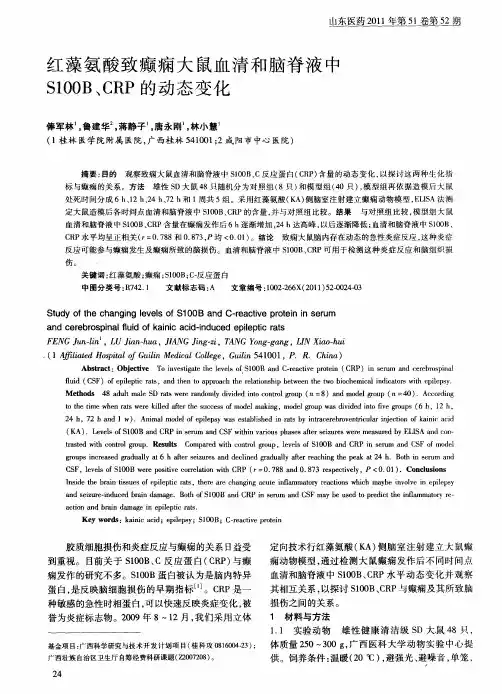
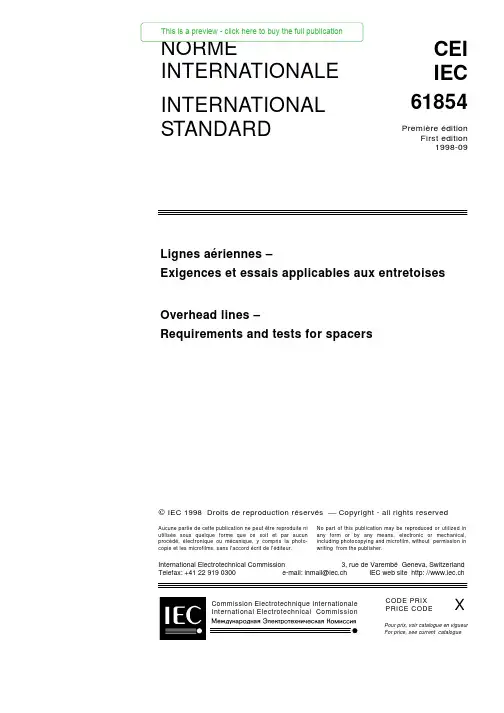
NORMEINTERNATIONALECEI IEC INTERNATIONALSTANDARD 61854Première éditionFirst edition1998-09Lignes aériennes –Exigences et essais applicables aux entretoisesOverhead lines –Requirements and tests for spacersCommission Electrotechnique InternationaleInternational Electrotechnical Commission Pour prix, voir catalogue en vigueurFor price, see current catalogue© IEC 1998 Droits de reproduction réservés Copyright - all rights reservedAucune partie de cette publication ne peut être reproduite niutilisée sous quelque forme que ce soit et par aucunprocédé, électronique ou mécanique, y compris la photo-copie et les microfilms, sans l'accord écrit de l'éditeur.No part of this publication may be reproduced or utilized in any form or by any means, electronic or mechanical,including photocopying and microfilm, without permission in writing from the publisher.International Electrotechnical Commission 3, rue de Varembé Geneva, SwitzerlandTelefax: +41 22 919 0300e-mail: inmail@iec.ch IEC web site http: //www.iec.chCODE PRIX PRICE CODE X– 2 –61854 © CEI:1998SOMMAIREPages AVANT-PROPOS (6)Articles1Domaine d'application (8)2Références normatives (8)3Définitions (12)4Exigences générales (12)4.1Conception (12)4.2Matériaux (14)4.2.1Généralités (14)4.2.2Matériaux non métalliques (14)4.3Masse, dimensions et tolérances (14)4.4Protection contre la corrosion (14)4.5Aspect et finition de fabrication (14)4.6Marquage (14)4.7Consignes d'installation (14)5Assurance de la qualité (16)6Classification des essais (16)6.1Essais de type (16)6.1.1Généralités (16)6.1.2Application (16)6.2Essais sur échantillon (16)6.2.1Généralités (16)6.2.2Application (16)6.2.3Echantillonnage et critères de réception (18)6.3Essais individuels de série (18)6.3.1Généralités (18)6.3.2Application et critères de réception (18)6.4Tableau des essais à effectuer (18)7Méthodes d'essai (22)7.1Contrôle visuel (22)7.2Vérification des dimensions, des matériaux et de la masse (22)7.3Essai de protection contre la corrosion (22)7.3.1Composants revêtus par galvanisation à chaud (autres queles fils d'acier galvanisés toronnés) (22)7.3.2Produits en fer protégés contre la corrosion par des méthodes autresque la galvanisation à chaud (24)7.3.3Fils d'acier galvanisé toronnés (24)7.3.4Corrosion causée par des composants non métalliques (24)7.4Essais non destructifs (24)61854 © IEC:1998– 3 –CONTENTSPage FOREWORD (7)Clause1Scope (9)2Normative references (9)3Definitions (13)4General requirements (13)4.1Design (13)4.2Materials (15)4.2.1General (15)4.2.2Non-metallic materials (15)4.3Mass, dimensions and tolerances (15)4.4Protection against corrosion (15)4.5Manufacturing appearance and finish (15)4.6Marking (15)4.7Installation instructions (15)5Quality assurance (17)6Classification of tests (17)6.1Type tests (17)6.1.1General (17)6.1.2Application (17)6.2Sample tests (17)6.2.1General (17)6.2.2Application (17)6.2.3Sampling and acceptance criteria (19)6.3Routine tests (19)6.3.1General (19)6.3.2Application and acceptance criteria (19)6.4Table of tests to be applied (19)7Test methods (23)7.1Visual examination (23)7.2Verification of dimensions, materials and mass (23)7.3Corrosion protection test (23)7.3.1Hot dip galvanized components (other than stranded galvanizedsteel wires) (23)7.3.2Ferrous components protected from corrosion by methods other thanhot dip galvanizing (25)7.3.3Stranded galvanized steel wires (25)7.3.4Corrosion caused by non-metallic components (25)7.4Non-destructive tests (25)– 4 –61854 © CEI:1998 Articles Pages7.5Essais mécaniques (26)7.5.1Essais de glissement des pinces (26)7.5.1.1Essai de glissement longitudinal (26)7.5.1.2Essai de glissement en torsion (28)7.5.2Essai de boulon fusible (28)7.5.3Essai de serrage des boulons de pince (30)7.5.4Essais de courant de court-circuit simulé et essais de compressionet de traction (30)7.5.4.1Essai de courant de court-circuit simulé (30)7.5.4.2Essai de compression et de traction (32)7.5.5Caractérisation des propriétés élastiques et d'amortissement (32)7.5.6Essais de flexibilité (38)7.5.7Essais de fatigue (38)7.5.7.1Généralités (38)7.5.7.2Oscillation de sous-portée (40)7.5.7.3Vibrations éoliennes (40)7.6Essais de caractérisation des élastomères (42)7.6.1Généralités (42)7.6.2Essais (42)7.6.3Essai de résistance à l'ozone (46)7.7Essais électriques (46)7.7.1Essais d'effet couronne et de tension de perturbations radioélectriques..467.7.2Essai de résistance électrique (46)7.8Vérification du comportement vibratoire du système faisceau/entretoise (48)Annexe A (normative) Informations techniques minimales à convenirentre acheteur et fournisseur (64)Annexe B (informative) Forces de compression dans l'essai de courantde court-circuit simulé (66)Annexe C (informative) Caractérisation des propriétés élastiques et d'amortissementMéthode de détermination de la rigidité et de l'amortissement (70)Annexe D (informative) Contrôle du comportement vibratoire du systèmefaisceau/entretoise (74)Bibliographie (80)Figures (50)Tableau 1 – Essais sur les entretoises (20)Tableau 2 – Essais sur les élastomères (44)61854 © IEC:1998– 5 –Clause Page7.5Mechanical tests (27)7.5.1Clamp slip tests (27)7.5.1.1Longitudinal slip test (27)7.5.1.2Torsional slip test (29)7.5.2Breakaway bolt test (29)7.5.3Clamp bolt tightening test (31)7.5.4Simulated short-circuit current test and compression and tension tests (31)7.5.4.1Simulated short-circuit current test (31)7.5.4.2Compression and tension test (33)7.5.5Characterisation of the elastic and damping properties (33)7.5.6Flexibility tests (39)7.5.7Fatigue tests (39)7.5.7.1General (39)7.5.7.2Subspan oscillation (41)7.5.7.3Aeolian vibration (41)7.6Tests to characterise elastomers (43)7.6.1General (43)7.6.2Tests (43)7.6.3Ozone resistance test (47)7.7Electrical tests (47)7.7.1Corona and radio interference voltage (RIV) tests (47)7.7.2Electrical resistance test (47)7.8Verification of vibration behaviour of the bundle-spacer system (49)Annex A (normative) Minimum technical details to be agreed betweenpurchaser and supplier (65)Annex B (informative) Compressive forces in the simulated short-circuit current test (67)Annex C (informative) Characterisation of the elastic and damping propertiesStiffness-Damping Method (71)Annex D (informative) Verification of vibration behaviour of the bundle/spacer system (75)Bibliography (81)Figures (51)Table 1 – Tests on spacers (21)Table 2 – Tests on elastomers (45)– 6 –61854 © CEI:1998 COMMISSION ÉLECTROTECHNIQUE INTERNATIONALE––––––––––LIGNES AÉRIENNES –EXIGENCES ET ESSAIS APPLICABLES AUX ENTRETOISESAVANT-PROPOS1)La CEI (Commission Electrotechnique Internationale) est une organisation mondiale de normalisation composéede l'ensemble des comités électrotechniques nationaux (Comités nationaux de la CEI). La CEI a pour objet de favoriser la coopération internationale pour toutes les questions de normalisation dans les domaines de l'électricité et de l'électronique. A cet effet, la CEI, entre autres activités, publie des Normes internationales.Leur élaboration est confiée à des comités d'études, aux travaux desquels tout Comité national intéressé par le sujet traité peut participer. Les organisations internationales, gouvernementales et non gouvernementales, en liaison avec la CEI, participent également aux travaux. La CEI collabore étroitement avec l'Organisation Internationale de Normalisation (ISO), selon des conditions fixées par accord entre les deux organisations.2)Les décisions ou accords officiels de la CEI concernant les questions techniques représentent, dans la mesuredu possible un accord international sur les sujets étudiés, étant donné que les Comités nationaux intéressés sont représentés dans chaque comité d’études.3)Les documents produits se présentent sous la forme de recommandations internationales. Ils sont publiéscomme normes, rapports techniques ou guides et agréés comme tels par les Comités nationaux.4)Dans le but d'encourager l'unification internationale, les Comités nationaux de la CEI s'engagent à appliquer defaçon transparente, dans toute la mesure possible, les Normes internationales de la CEI dans leurs normes nationales et régionales. Toute divergence entre la norme de la CEI et la norme nationale ou régionale correspondante doit être indiquée en termes clairs dans cette dernière.5)La CEI n’a fixé aucune procédure concernant le marquage comme indication d’approbation et sa responsabilitén’est pas engagée quand un matériel est déclaré conforme à l’une de ses normes.6) L’attention est attirée sur le fait que certains des éléments de la présente Norme internationale peuvent fairel’objet de droits de propriété intellectuelle ou de droits analogues. La CEI ne saurait être tenue pour responsable de ne pas avoir identifié de tels droits de propriété et de ne pas avoir signalé leur existence.La Norme internationale CEI 61854 a été établie par le comité d'études 11 de la CEI: Lignes aériennes.Le texte de cette norme est issu des documents suivants:FDIS Rapport de vote11/141/FDIS11/143/RVDLe rapport de vote indiqué dans le tableau ci-dessus donne toute information sur le vote ayant abouti à l'approbation de cette norme.L’annexe A fait partie intégrante de cette norme.Les annexes B, C et D sont données uniquement à titre d’information.61854 © IEC:1998– 7 –INTERNATIONAL ELECTROTECHNICAL COMMISSION––––––––––OVERHEAD LINES –REQUIREMENTS AND TESTS FOR SPACERSFOREWORD1)The IEC (International Electrotechnical Commission) is a worldwide organization for standardization comprisingall national electrotechnical committees (IEC National Committees). The object of the IEC is to promote international co-operation on all questions concerning standardization in the electrical and electronic fields. To this end and in addition to other activities, the IEC publishes International Standards. Their preparation is entrusted to technical committees; any IEC National Committee interested in the subject dealt with may participate in this preparatory work. International, governmental and non-governmental organizations liaising with the IEC also participate in this preparation. The IEC collaborates closely with the International Organization for Standardization (ISO) in accordance with conditions determined by agreement between the two organizations.2)The formal decisions or agreements of the IEC on technical matters express, as nearly as possible, aninternational consensus of opinion on the relevant subjects since each technical committee has representation from all interested National Committees.3)The documents produced have the form of recommendations for international use and are published in the formof standards, technical reports or guides and they are accepted by the National Committees in that sense.4)In order to promote international unification, IEC National Committees undertake to apply IEC InternationalStandards transparently to the maximum extent possible in their national and regional standards. Any divergence between the IEC Standard and the corresponding national or regional standard shall be clearly indicated in the latter.5)The IEC provides no marking procedure to indicate its approval and cannot be rendered responsible for anyequipment declared to be in conformity with one of its standards.6) Attention is drawn to the possibility that some of the elements of this International Standard may be the subjectof patent rights. The IEC shall not be held responsible for identifying any or all such patent rights. International Standard IEC 61854 has been prepared by IEC technical committee 11: Overhead lines.The text of this standard is based on the following documents:FDIS Report on voting11/141/FDIS11/143/RVDFull information on the voting for the approval of this standard can be found in the report on voting indicated in the above table.Annex A forms an integral part of this standard.Annexes B, C and D are for information only.– 8 –61854 © CEI:1998LIGNES AÉRIENNES –EXIGENCES ET ESSAIS APPLICABLES AUX ENTRETOISES1 Domaine d'applicationLa présente Norme internationale s'applique aux entretoises destinées aux faisceaux de conducteurs de lignes aériennes. Elle recouvre les entretoises rigides, les entretoises flexibles et les entretoises amortissantes.Elle ne s'applique pas aux espaceurs, aux écarteurs à anneaux et aux entretoises de mise à la terre.NOTE – La présente norme est applicable aux pratiques de conception de lignes et aux entretoises les plus couramment utilisées au moment de sa rédaction. Il peut exister d'autres entretoises auxquelles les essais spécifiques décrits dans la présente norme ne s'appliquent pas.Dans de nombreux cas, les procédures d'essai et les valeurs d'essai sont convenues entre l'acheteur et le fournisseur et sont énoncées dans le contrat d'approvisionnement. L'acheteur est le mieux à même d'évaluer les conditions de service prévues, qu'il convient d'utiliser comme base à la définition de la sévérité des essais.La liste des informations techniques minimales à convenir entre acheteur et fournisseur est fournie en annexe A.2 Références normativesLes documents normatifs suivants contiennent des dispositions qui, par suite de la référence qui y est faite, constituent des dispositions valables pour la présente Norme internationale. Au moment de la publication, les éditions indiquées étaient en vigueur. Tout document normatif est sujet à révision et les parties prenantes aux accords fondés sur la présente Norme internationale sont invitées à rechercher la possibilité d'appliquer les éditions les plus récentes des documents normatifs indiqués ci-après. Les membres de la CEI et de l'ISO possèdent le registre des Normes internationales en vigueur.CEI 60050(466):1990, Vocabulaire Electrotechnique International (VEI) – Chapitre 466: Lignes aériennesCEI 61284:1997, Lignes aériennes – Exigences et essais pour le matériel d'équipementCEI 60888:1987, Fils en acier zingué pour conducteurs câblésISO 34-1:1994, Caoutchouc vulcanisé ou thermoplastique – Détermination de la résistance au déchirement – Partie 1: Eprouvettes pantalon, angulaire et croissantISO 34-2:1996, Caoutchouc vulcanisé ou thermoplastique – Détermination de la résistance au déchirement – Partie 2: Petites éprouvettes (éprouvettes de Delft)ISO 37:1994, Caoutchouc vulcanisé ou thermoplastique – Détermination des caractéristiques de contrainte-déformation en traction61854 © IEC:1998– 9 –OVERHEAD LINES –REQUIREMENTS AND TESTS FOR SPACERS1 ScopeThis International Standard applies to spacers for conductor bundles of overhead lines. It covers rigid spacers, flexible spacers and spacer dampers.It does not apply to interphase spacers, hoop spacers and bonding spacers.NOTE – This standard is written to cover the line design practices and spacers most commonly used at the time of writing. There may be other spacers available for which the specific tests reported in this standard may not be applicable.In many cases, test procedures and test values are left to agreement between purchaser and supplier and are stated in the procurement contract. The purchaser is best able to evaluate the intended service conditions, which should be the basis for establishing the test severity.In annex A, the minimum technical details to be agreed between purchaser and supplier are listed.2 Normative referencesThe following normative documents contain provisions which, through reference in this text, constitute provisions of this International Standard. At the time of publication of this standard, the editions indicated were valid. All normative documents are subject to revision, and parties to agreements based on this International Standard are encouraged to investigate the possibility of applying the most recent editions of the normative documents indicated below. Members of IEC and ISO maintain registers of currently valid International Standards.IEC 60050(466):1990, International Electrotechnical vocabulary (IEV) – Chapter 466: Overhead linesIEC 61284:1997, Overhead lines – Requirements and tests for fittingsIEC 60888:1987, Zinc-coated steel wires for stranded conductorsISO 34-1:1994, Rubber, vulcanized or thermoplastic – Determination of tear strength – Part 1: Trouser, angle and crescent test piecesISO 34-2:1996, Rubber, vulcanized or thermoplastic – Determination of tear strength – Part 2: Small (Delft) test piecesISO 37:1994, Rubber, vulcanized or thermoplastic – Determination of tensile stress-strain properties– 10 –61854 © CEI:1998 ISO 188:1982, Caoutchouc vulcanisé – Essais de résistance au vieillissement accéléré ou à la chaleurISO 812:1991, Caoutchouc vulcanisé – Détermination de la fragilité à basse températureISO 815:1991, Caoutchouc vulcanisé ou thermoplastique – Détermination de la déformation rémanente après compression aux températures ambiantes, élevées ou bassesISO 868:1985, Plastiques et ébonite – Détermination de la dureté par pénétration au moyen d'un duromètre (dureté Shore)ISO 1183:1987, Plastiques – Méthodes pour déterminer la masse volumique et la densitérelative des plastiques non alvéolairesISO 1431-1:1989, Caoutchouc vulcanisé ou thermoplastique – Résistance au craquelage par l'ozone – Partie 1: Essai sous allongement statiqueISO 1461,— Revêtements de galvanisation à chaud sur produits finis ferreux – Spécifications1) ISO 1817:1985, Caoutchouc vulcanisé – Détermination de l'action des liquidesISO 2781:1988, Caoutchouc vulcanisé – Détermination de la masse volumiqueISO 2859-1:1989, Règles d'échantillonnage pour les contrôles par attributs – Partie 1: Plans d'échantillonnage pour les contrôles lot par lot, indexés d'après le niveau de qualité acceptable (NQA)ISO 2859-2:1985, Règles d'échantillonnage pour les contrôles par attributs – Partie 2: Plans d'échantillonnage pour les contrôles de lots isolés, indexés d'après la qualité limite (QL)ISO 2921:1982, Caoutchouc vulcanisé – Détermination des caractéristiques à basse température – Méthode température-retrait (essai TR)ISO 3417:1991, Caoutchouc – Détermination des caractéristiques de vulcanisation à l'aide du rhéomètre à disque oscillantISO 3951:1989, Règles et tables d'échantillonnage pour les contrôles par mesures des pourcentages de non conformesISO 4649:1985, Caoutchouc – Détermination de la résistance à l'abrasion à l'aide d'un dispositif à tambour tournantISO 4662:1986, Caoutchouc – Détermination de la résilience de rebondissement des vulcanisats––––––––––1) A publierThis is a preview - click here to buy the full publication61854 © IEC:1998– 11 –ISO 188:1982, Rubber, vulcanized – Accelerated ageing or heat-resistance testsISO 812:1991, Rubber, vulcanized – Determination of low temperature brittlenessISO 815:1991, Rubber, vulcanized or thermoplastic – Determination of compression set at ambient, elevated or low temperaturesISO 868:1985, Plastics and ebonite – Determination of indentation hardness by means of a durometer (Shore hardness)ISO 1183:1987, Plastics – Methods for determining the density and relative density of non-cellular plasticsISO 1431-1:1989, Rubber, vulcanized or thermoplastic – Resistance to ozone cracking –Part 1: static strain testISO 1461, — Hot dip galvanized coatings on fabricated ferrous products – Specifications1)ISO 1817:1985, Rubber, vulcanized – Determination of the effect of liquidsISO 2781:1988, Rubber, vulcanized – Determination of densityISO 2859-1:1989, Sampling procedures for inspection by attributes – Part 1: Sampling plans indexed by acceptable quality level (AQL) for lot-by-lot inspectionISO 2859-2:1985, Sampling procedures for inspection by attributes – Part 2: Sampling plans indexed by limiting quality level (LQ) for isolated lot inspectionISO 2921:1982, Rubber, vulcanized – Determination of low temperature characteristics –Temperature-retraction procedure (TR test)ISO 3417:1991, Rubber – Measurement of vulcanization characteristics with the oscillating disc curemeterISO 3951:1989, Sampling procedures and charts for inspection by variables for percent nonconformingISO 4649:1985, Rubber – Determination of abrasion resistance using a rotating cylindrical drum deviceISO 4662:1986, Rubber – Determination of rebound resilience of vulcanizates–––––––––1) To be published.。
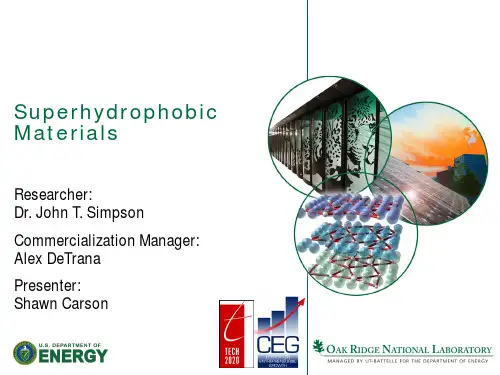
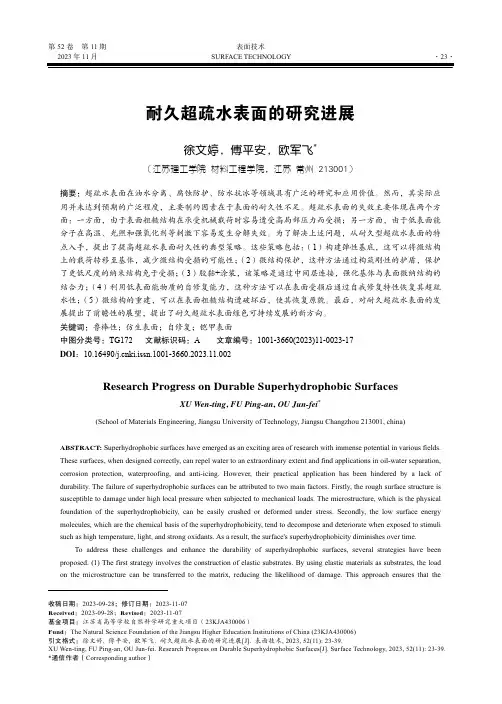
第52卷第11期表面技术2023年11月SURFACE TECHNOLOGY·23·耐久超疏水表面的研究进展徐文婷,傅平安,欧军飞*(江苏理工学院 材料工程学院,江苏 常州 213001)摘要:超疏水表面在油水分离、腐蚀防护、防水抗冰等领域具有广泛的研究和应用价值。
然而,其实际应用并未达到预期的广泛程度,主要制约因素在于表面的耐久性不足。
超疏水表面的失效主要体现在两个方面:一方面,由于表面粗糙结构在承受机械载荷时容易遭受高局部压力而受损;另一方面,由于低表面能分子在高温、光照和强氧化剂等刺激下容易发生分解失效。
为了解决上述问题,从耐久型超疏水表面的特点入手,提出了提高超疏水表面耐久性的典型策略。
这些策略包括:(1)构建弹性基底,这可以将微结构上的载荷转移至基体,减少微结构受损的可能性;(2)微结构保护,这种方法通过构筑刚性的护盾,保护了更低尺度的纳米结构免于受损;(3)胶黏+涂装,该策略是通过中间层连接,强化基体与表面微纳结构的结合力;(4)利用低表面能物质的自修复能力,这种方法可以在表面受损后通过自我修复特性恢复其超疏水性;(5)微结构的重建,可以在表面粗糙结构遭破坏后,使其恢复原貌。
最后,对耐久超疏水表面的发展提出了前瞻性的展望,提出了耐久超疏水表面绿色可持续发展的新方向。
关键词:鲁棒性;仿生表面;自修复;铠甲表面中图分类号:TG172 文献标识码:A 文章编号:1001-3660(2023)11-0023-17DOI:10.16490/ki.issn.1001-3660.2023.11.002Research Progress on Durable Superhydrophobic SurfacesXU Wen-ting, FU Ping-an, OU Jun-fei(School of Materials Engineering, Jiangsu University of Technology, Jiangsu Changzhou 213001, china)ABSTRACT: Superhydrophobic surfaces have emerged as an exciting area of research with immense potential in various fields.These surfaces, when designed correctly, can repel water to an extraordinary extent and find applications in oil-water separation, corrosion protection, waterproofing, and anti-icing. However, their practical application has been hindered by a lack of durability. The failure of superhydrophobic surfaces can be attributed to two main factors. Firstly, the rough surface structure is susceptible to damage under high local pressure when subjected to mechanical loads. The microstructure, which is the physical foundation of the superhydrophobicity, can be easily crushed or deformed under stress. Secondly, the low surface energy molecules, which are the chemical basis of the superhydrophobicity, tend to decompose and deteriorate when exposed to stimuli such as high temperature, light, and strong oxidants. As a result, the surface's superhydrophobicity diminishes over time.To address these challenges and enhance the durability of superhydrophobic surfaces, several strategies have been proposed. (1) The first strategy involves the construction of elastic substrates. By using elastic materials as substrates, the load on the microstructure can be transferred to the matrix, reducing the likelihood of damage. This approach ensures that the收稿日期:2023-09-28;修订日期:2023-11-07Received:2023-09-28;Revised:2023-11-07基金项目:江苏省高等学校自然科学研究重大项目(23KJA430006)Fund:The Natural Science Foundation of the Jiangsu Higher Education Institutions of China (23KJA430006)引文格式:徐文婷, 傅平安, 欧军飞. 耐久超疏水表面的研究进展[J]. 表面技术, 2023, 52(11): 23-39.XU Wen-ting, FU Ping-an, OU Jun-fei. Research Progress on Durable Superhydrophobic Surfaces[J]. Surface Technology, 2023, 52(11): 23-39. *通信作者(Corresponding author)·24·表面技术 2023年11月superhydrophobic surface remains intact even under mechanical stress. (2) The second strategy is microstructure protection. A protective shield can be constructed to safeguard the delicate micro/nanostructures from damage. This rigid shield acts as a barrier, shielding the micro/nanostructures from external forces or harsh conditions. Using materials with high mechanical strength and chemical stability prevents the degradation of the micro/nanostructure. (3) The third strategy is utilizing an adhesive+coating. By using an intermediate layer, the adhesion between the substrate and surface micro/nanostructures can be enhanced. This adhesive layer improves the overall durability of the superhydrophobic surface by providing additional support and stability. (4) The fourth strategy involves the use of self-healing materials. Superhydrophobic surfaces can be made from low surface energy materials with self-healing capabilities. These materials can restore their superhydrophobicity even after the surface has been damaged or compromised. This property ensures that the surface can maintain its water-repellent properties over a longer period. (5) The fifth strategy is the reconstruction of microstructures. This approach involves repairing or replacing the damaged microstructures to restore the surface's superhydrophobic properties and performance.Looking ahead, the development of durable superhydrophobic surfaces holds great promise. It offers new opportunities for green and sustainable solutions in various industries. By incorporating the aforementioned strategies, researchers and engineers can create superhydrophobic surfaces that are not only highly efficient but also long-lasting and resilient. These durability enhancement strategies pave the way for the practical implementation of superhydrophobic surfaces in real-world applications, enabling their widespread use and impact. This will contribute to the development of green and sustainable technologies for a wide range of applications.In conclusion, the development of durable superhydrophobic surfaces is crucial for advancing the fields of oil-water separation, corrosion protection, waterproofing, and anti-icing. By addressing the challenges related to surface durability through strategies such as constructing elastic substrates, microstructure protection, adhesive+coating, utilizing self-healing materials, and reconstructing microstructures, the practical application of superhydrophobic surfaces can be significantly enhanced. This will contribute to the development of green and sustainable technologies for a wide range of applications.KEY WORDS: robust; bio-inspred surface; self-healing; armoured surface随着生物进化的不断演进,自然界中许多生物逐渐进化出了具有超疏水性的表面,这些表面具有独特的微观结构和低表面能物质,使得水滴在其表面难以附着[1-5]。
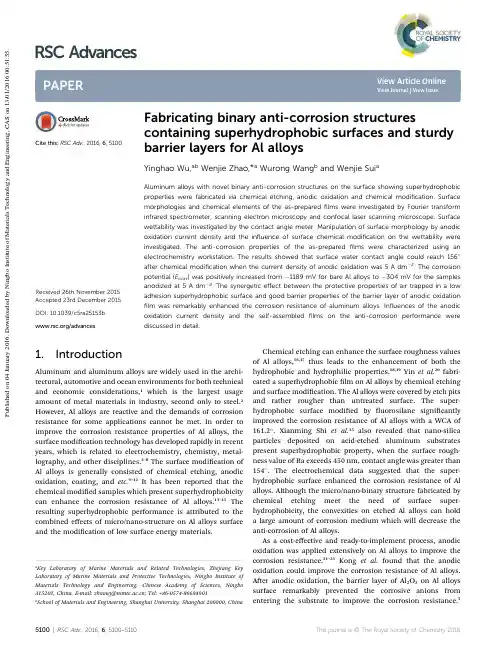

第51卷第1期2020年1月中南大学学报(自然科学版)Journal of Central South University(Science and Technology)V ol.51No.1Jan.2020结霜初期超疏水表面液滴生长的规律赵伟,梁彩华,成赛凤,罗倩妮(东南大学能源与环境学院,江苏南京,210096)摘要:为了研究结霜初期液滴在超疏水表面的生长规律,建立结霜初期超疏水表面液滴生长的分层模型,揭示液滴在生长过程中各层温差的分布特点,并深入研究表面接触角、面积分数、基底温度以及空气相对湿度对液滴生长的影响规律。
研究结果表明:在结霜初期,液滴的Knudsen层以及主流连续区层这2部分的温差占基底过冷度的95%以上;随着表面接触角的增大,传质环节中的主流连续区层的温差减小,导致液滴生长减缓;面积分数S对液滴生长的影响较小,当S=0.04时,与其相关的热阻Rwe仅约占液滴-翅片层总热阻的0.2%;液滴生长速率随着基底温度的降低和空气相对湿度的升高而升高。
关键词:超疏水表面;液滴生长;接触角;面积分数中图分类号:TK124文献标志码:A文章编号:1672-7207(2020)01-0231-08Rule of droplets growth in the early stage of frost formation onsuperhydrophobic surfacesZHAO Wei,LIANG Caihua,CHENG Saifeng,LUO Qianni(School of Energy and Environment,Southeast University,Nanjing210096,China) Abstract:In order to study the droplets growth on the superhydrophobic surfaces in the early stage of frostformation,the model of droplets growth under frosting conditions was established.The proportion of the temperature difference of each layer in the droplets growth process was analyzed.The effects of contact angle, area fraction,substrate temperature and relative humidity on droplets growth were studied.The results show that in the early stage of frost formation,the temperature difference of the Knudsen layer and the continuum region layer account for more than95%of the total temperature difference.With the increase of surface contact angle,the temperature difference of continuum region layer decreases,which leads to the slow growth of droplets.The areafraction S has little effect on the droplets growth.When S=0.04,the related thermal resistance Rweonly accounts for about0.2%of the total thermal resistance of the droplet-fin layer.The rate of droplets growth increases as the substrate temperature decreases and the relative humidity of the air increases.Key words:superhydrophobic surfaces;droplets growth;contact angle;area fractionDOI:10.11817/j.issn.1672-7207.2020.01.026收稿日期:2019−03−12;修回日期:2019−05−23基金项目(Foundation item):国家自然科学基金资助项目(51676033);“十三五”国家重点研发计划项目(2016YFC700304) (Project(51676033)supported by the National Natural Science Foundation of China;Project(2016YFC700304)supported by the National Key R&D Programs during the13th Five-Year Plan Period)通信作者:梁彩华,博士,教授,博士生导师,从事制冷空调、建筑节能及可再生能源利用研究;E-mail:caihualiang@163.com第51卷中南大学学报(自然科学版)空气源热泵在冬季制热运行时不可避免地会出现结霜现象。
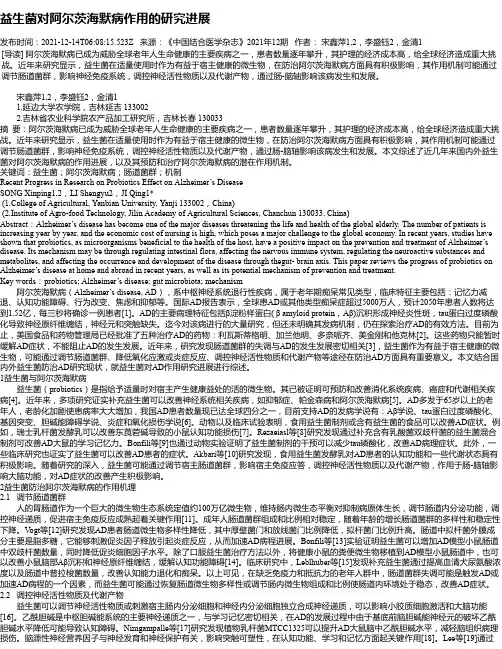
益生菌对阿尔茨海默病作用的研究进展发布时间:2021-12-14T06:08:15.523Z 来源:《中国结合医学杂志》2021年12期作者:宋鑫萍1,2,李盛钰2,金清1[导读] 阿尔茨海默病已成为威胁全球老年人生命健康的主要疾病之一,患者数量逐年攀升,其护理的经济成本高,给全球经济造成重大挑战。
近年来研究显示,益生菌在适量使用时作为有益于宿主健康的微生物,在防治阿尔茨海默病方面具有积极影响,其作用机制可能通过调节肠道菌群,影响神经免疫系统,调控神经活性物质以及代谢产物,通过肠-脑轴影响该病发生和发展。
宋鑫萍1,2,李盛钰2,金清11.延边大学农学院,吉林延吉 1330022.吉林省农业科学院农产品加工研究所,吉林长春 130033摘要:阿尔茨海默病已成为威胁全球老年人生命健康的主要疾病之一,患者数量逐年攀升,其护理的经济成本高,给全球经济造成重大挑战。
近年来研究显示,益生菌在适量使用时作为有益于宿主健康的微生物,在防治阿尔茨海默病方面具有积极影响,其作用机制可能通过调节肠道菌群,影响神经免疫系统,调控神经活性物质以及代谢产物,通过肠-脑轴影响该病发生和发展。
本文综述了近几年来国内外益生菌对阿尔茨海默病的作用进展,以及其预防和治疗阿尔茨海默病的潜在作用机制。
关键词:益生菌;阿尔茨海默病;肠道菌群;机制Recent Progress in Research on Probiotics Effect on Alzheimer’s DiseaseSONG Xinping1,2,LI Shengyu2,JI Qing1*(1.College of Agricultural, Yanbian University, Yanji 133002,China)(2.Institute of Agro-food Technology, Jilin Academy of Agricultural Sciences, Chanchun 130033, China)Abstract:Alzheimer’s disease has become one of the major diseases threatening the life and health of the global elderly. The number of patients is increasing year by year, and the economic cost of nursing is high, which poses a major challenge to the global economy. In recent years, studies have shown that probiotics, as microorganisms beneficial to the health of the host, have a positive impact on the prevention and treatment of Alzheimer’s disease. Its mechanism may be through regulating intestinal flora, affecting the nervous immune system, regulating the neuroactive substances and metabolites, and affecting the occurrence and development of the disease through thegut- brain axis. This paper reviews the progress of probiotics on Alzheimer’s disease at home and abroad in recent years, as well as its potential mechanism of prevention and treatment.Key words:probiotics; Alzheimer’s disease; gut microbiota; mechanism阿尔茨海默病(Alzheimer’s disease, AD),系中枢神经系统退行性疾病,属于老年期痴呆常见类型,临床特征主要包括:记忆力减退、认知功能障碍、行为改变、焦虑和抑郁等。
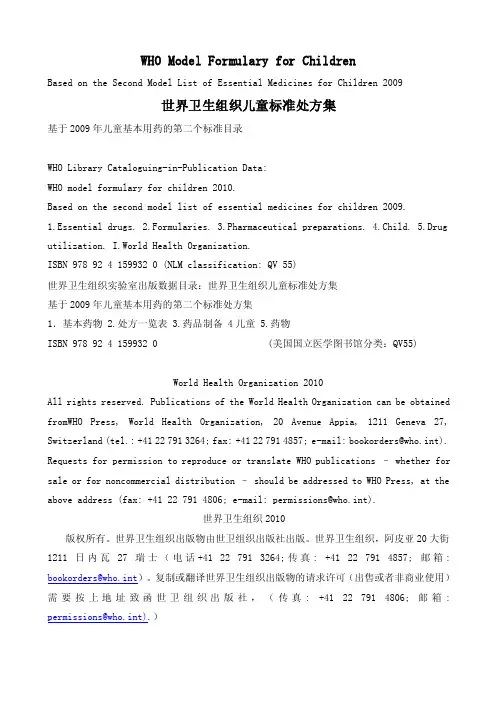
WHO Model Formulary for ChildrenBased on the Second Model List of Essential Medicines for Children 2009世界卫生组织儿童标准处方集基于2009年儿童基本用药的第二个标准目录WHO Library Cataloguing-in-Publication Data:WHO model formulary for children 2010.Based on the second model list of essential medicines for children 2009.1.Essential drugs.2.Formularies.3.Pharmaceutical preparations.4.Child.5.Drug utilization. I.World Health Organization.ISBN 978 92 4 159932 0 (NLM classification: QV 55)世界卫生组织实验室出版数据目录:世界卫生组织儿童标准处方集基于2009年儿童基本用药的第二个标准处方集1.基本药物 2.处方一览表 3.药品制备 4儿童 5.药物ISBN 978 92 4 159932 0 (美国国立医学图书馆分类:QV55)World Health Organization 2010All rights reserved. Publications of the World Health Organization can be obtained fromWHO Press, World Health Organization, 20 Avenue Appia, 1211 Geneva 27, Switzerland (tel.: +41 22 791 3264; fax: +41 22 791 4857; e-mail: ******************). Requests for permission to reproduce or translate WHO publications – whether for sale or for noncommercial distribution – should be addressed to WHO Press, at the aboveaddress(fax:+41227914806;e-mail:*******************).世界卫生组织2010版权所有。
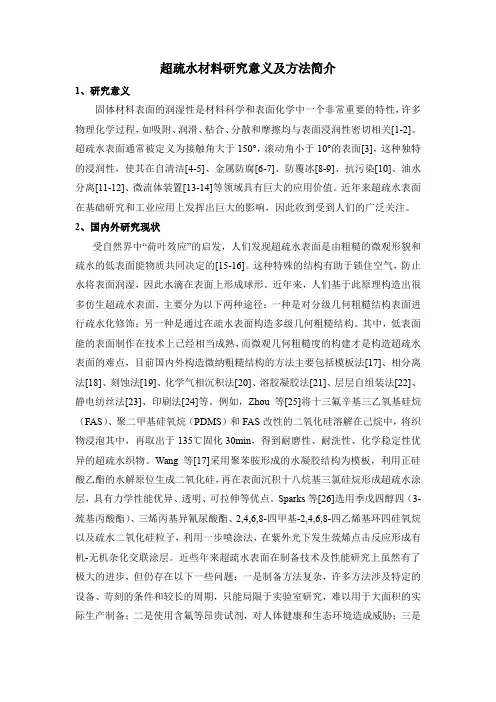
超疏水材料研究意义及方法简介1、研究意义固体材料表面的润湿性是材料科学和表面化学中一个非常重要的特性,许多物理化学过程,如吸附、润滑、粘合、分散和摩擦均与表面浸润性密切相关[1-2]。
超疏水表面通常被定义为接触角大于150°,滚动角小于10°的表面[3],这种独特的浸润性,使其在自清洁[4-5]、金属防腐[6-7]、防覆冰[8-9]、抗污染[10]、油水分离[11-12]、微流体装置[13-14]等领域具有巨大的应用价值。
近年来超疏水表面在基础研究和工业应用上发挥出巨大的影响,因此收到受到人们的广泛关注。
2、国内外研究现状受自然界中“荷叶效应”的启发,人们发现超疏水表面是由粗糙的微观形貌和疏水的低表面能物质共同决定的[15-16]。
这种特殊的结构有助于锁住空气,防止水将表面润湿,因此水滴在表面上形成球形。
近年来,人们基于此原理构造出很多仿生超疏水表面,主要分为以下两种途径:一种是对分级几何粗糙结构表面进行疏水化修饰;另一种是通过在疏水表面构造多级几何粗糙结构。
其中,低表面能的表面制作在技术上已经相当成熟,而微观几何粗糙度的构建才是构造超疏水表面的难点,目前国内外构造微纳粗糙结构的方法主要包括模板法[17]、相分离法[18]、刻蚀法[19]、化学气相沉积法[20]、溶胶凝胶法[21]、层层自组装法[22]、静电纺丝法[23]、印刷法[24]等。
例如,Zhou等[25]将十三氟辛基三乙氧基硅烷(FAS)、聚二甲基硅氧烷(PDMS)和FAS改性的二氧化硅溶解在己烷中,将织物浸泡其中,再取出于135℃固化30min,得到耐磨性、耐洗性、化学稳定性优异的超疏水织物。
Wang等[17]采用聚苯胺形成的水凝胶结构为模板,利用正硅酸乙酯的水解原位生成二氧化硅,再在表面沉积十八烷基三氯硅烷形成超疏水涂层,具有力学性能优异、透明、可拉伸等优点。
Sparks等[26]选用季戊四醇四(3-巯基丙酸酯)、三烯丙基异氰尿酸酯、2,4,6,8-四甲基-2,4,6,8-四乙烯基环四硅氧烷以及疏水二氧化硅粒子,利用一步喷涂法,在紫外光下发生巯烯点击反应形成有机-无机杂化交联涂层。
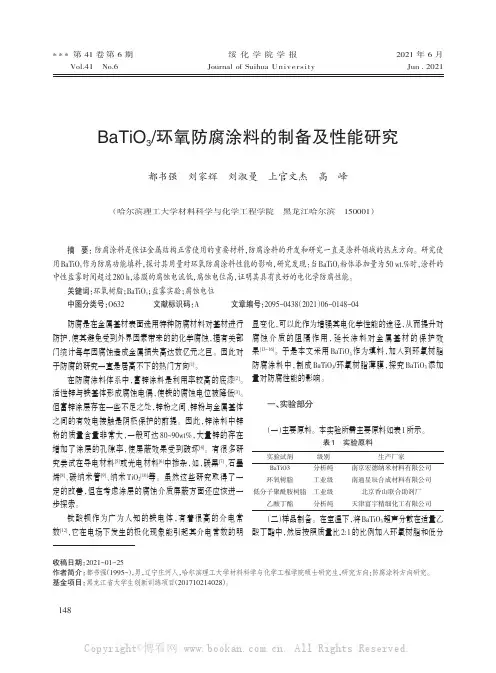
BaTiO 3/环氧防腐涂料的制备及性能研究摘要:防腐涂料是保证金属结构正常使用的重要材料,防腐涂料的开发和研究一直是涂料领域的热点方向。
研究使用BaTiO 3作为防腐功能填料,探讨其用量对环氧防腐涂料性能的影响,研究发现:当BaTiO 3粉体添加量为50wt.%时,涂料的中性盐雾时间超过280h ,漆膜的腐蚀电流低,腐蚀电位高,证明其具有良好的电化学防腐性能。
关键词:环氧树脂;BaTiO 3;盐雾实验;腐蚀电位中图分类号:O632文献标识码:A 文章编号:2095-0438(2021)06-0148-04(哈尔滨理工大学材料科学与化学工程学院黑龙江哈尔滨150001)防腐是在金属基材表面选用特种防腐材料对基材进行防护,使其避免受到外界因素带来的的化学腐蚀,据有关部门统计每年因腐蚀造成金属损失高达数亿元之巨。
因此对于防腐的研究一直是居高不下的热门方向[1]。
在防腐涂料体系中,富锌涂料是利用率较高的底漆[2]。
活性锌与铁基体形成腐蚀电偶,使铁的腐蚀电位被降低[3]。
但富锌涂层存在一些不足之处,锌粉之间、锌粉与金属基体之间的有效电接触是阴极保护的前提。
因此,锌涂料中锌粉的质量含量非常大,一般可达80~90wt%,大量锌的存在增加了涂层的孔隙率,使屏蔽效果受到破坏[4]。
有很多研究尝试在导电材料[5]或光电材料[6]中掺杂,如,碳黑[7]、石墨烯[8]、碳纳米管[9]、纳米TiO 2[10]等。
虽然这些研究取得了一定的改善,但在考虑涂层的腐蚀介质屏蔽方面还应该进一步探索。
钛酸钡作为广为人知的铁电体,有着很高的介电常数[12],它在电场下发生的极化现象能引起其介电常数的明显变化,可以此作为增强其电化学性能的途径,从而提升对腐蚀介质的阻隔作用,延长涂料对金属基材的保护效果[13-16]。
于是本文采用BaTiO 3作为填料,加入到环氧树脂防腐涂料中,制成BaTiO 3/环氧树脂薄膜,探究BaTiO 3添加量对防腐性能的影响。
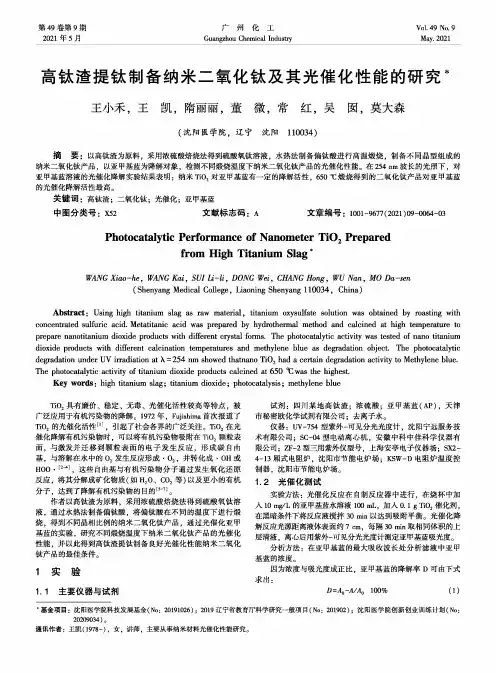
第49卷第9期2021年5月广州化工Guangzhou Chemical IndustryVol. 49 No. 9May. 2021高钛渣提钛制备纳米二氧化钛及其光催化性能的研究**基金项目:沈阳医学院科技发展基金(No : 20191026) ; 2019辽宁省教育厅科学研究一般项目(N 。
: 201902);沈阳医学院创新创业训练计划(N 。
: 20209034)D通讯作者:王凯(1978-),女,讲师,主要从事纳米材料光催化性能研究。
王小禾,王 凯,隋丽丽,董微,常红,吴 園,莫大森(沈阳医学院,辽宁沈阳110034)摘 要:以高钛渣为原料,采用浓硫酸焙烧法得到硫酸氧钛溶液,水热法制备偏钛酸进行高温锻烧,制备不同晶型组成的纳米二氧化钛产品,以亚甲基蓝为降解对象,检测不同熾烧温度下纳米二氧化钛产品的光催化性能。
在254 nm 波长的光照下,对亚甲基蓝溶液的光催化降解实验结果表明:纳米Ti()2对亚甲基蓝有一定的降解活性,650 t 锻烧得到的二氧化钛产品对亚甲基蓝 的光催化降解活性最高。
关键词:高钛渣;二氧化钛;光催化;亚甲基蓝中图分类号: X52文献标志码:A 文章编号:1001 -9677(2021)09-0064-03Photocatalytic Performance of Nanometer TiO 2 Preparedfrom High Titanium Slag *WANGXiao-he, WANG Kai, SUI Li-li, DONG Wei, CHANG Hong, WU Nan, MO Da-sen(Shenyang Medical College , Liaoning Shenyang 110034, China)Abstract : Using high titanium slag as raw material , titanium oxysulfate solution was obtained by roasting withconcentrated sulfuric acid. Metatitanic acid was prepared by hydrothermal method and calcined at high temperature toprepare nanotitanium dioxide products with different crystal form& The photocatalytic activity was tested of nano titanium dioxide products with different calcination temperatures and methylene blue as degradation object. The photocatalyticdegradation under UV irradiation at k = 254 nm showed thatnano TiO 2 had a certain degradation activity to Methylene blue. The photocatalytic activity of titanium dioxide products calcined at 650 P was the highest.Key words : high titanium slag ; titanium dioxide ; photocatalysis ; methylene blueTiOz 具有廉价、稳定、无毒、光催化活性较高等特点,被广泛应用于有机污染物的降解。
第52卷第11期表面技术2023年11月SURFACE TECHNOLOGY·63·基于多孔黏结层的超疏水复合涂层制备及其耐磨性研究汪希奎1,2,苏一凡1,程真1,花颢轩1,刘星宇1,王蕊1,周张恒1,侯泽钟1,李卓然1,赵俊豪1,张友法1*(1.东南大学 a.材料科学与工程学院 b.江苏省先进金属材料高技术研究重点实验室,南京 211189;2.贵州大学 机械工程学院,贵阳 550025)摘要:目的提高超疏水涂层的耐磨性。
方法采用底面复合方法增强超疏水涂层的附着性和耐磨性,通过发泡剂在树脂底漆表面形成均匀孔隙结构,使喷涂于底漆表面的部分超疏水纳米颗粒嵌入孔隙中,通过硬化树脂的凸起结构有效保护超疏水纳米颗粒,从而提高涂层整体的耐磨性。
在摩擦磨损试验机上开展橡胶磨损测试,综合评价涂层的耐磨性能,并通过扫描电子显微镜和同轴光学显微镜对涂层表面的原始形貌及磨损形貌进行分析,通过接触角测量仪对涂层磨损前后的表面润湿性进行测试。
结果当异构十六烷的质量分数为50%、预热温度为130 ℃、预热时间为100 s时,在底漆表面可形成较深且分布均匀的孔隙结构,基于该底漆制备的超疏水复合涂层的耐磨性相对更好。
在30 N载荷下,优化涂层经橡胶磨损700次后,仍能保持较好的疏水性。
结论通过发泡剂对底面复合涂层进行改进,可有效提高超疏水纳米涂层与基底之间的黏结强度;底漆表面的孔隙结构有利于超疏水颗粒的嵌入,充分利用硬化树脂的凸起结构对嵌入的超疏水颗粒进行保护,可有效提高底面复合超疏水涂层的整体耐磨性。
关键词:超疏水;纳米涂层;耐磨性;树脂底漆;发泡剂;孔隙结构中图分类号:TB332 文献标识码:A 文章编号:1001-3660(2023)11-0063-09DOI:10.16490/ki.issn.1001-3660.2023.11.005Fabrication and Wear Resistance of Robust SuperhydrophobicComposite Coating Based on Porous Adhesive LayerWANG Xi-kui1,2, SU Yi-fan1, CHENG Zhen1, HUA Hao-xuan1, LIU Xing-yu1, WANG Rui1,ZHOU Zhang-heng1, HOU Ze-zhong1, LI Zhuo-ran1, ZHAO Jun-hao1, ZHANG You-fa1*(1. a. School of Materials Science and Engineering, b. Jiangsu Key Laboratory of Advanced Metallic Materials, SoutheastUniversity, Nanjing 211189, China; 2. School of Mechanical Engineering, Guizhou University, Guiyang 550025, China)ABSTRACT: Superhydrophobic surface is a nanostructured surface that can provide excellent waterproof, dustproof and anti-fouling properties. In the past few years, a surge has been seen in research interest in these surfaces, particularly in收稿日期:2023-07-02;修订日期:2023-10-10Received:2023-07-02;Revised:2023-10-10基金项目:国家自然科学基金(52071076,52205304);贵州大学自然科学专项(特岗)项目((2023)25)Fund:National Natural Science Foundation of China (52071076, 52205304); Natural Science Special Program of Guizhou University for Special Post ((2023) 25)引文格式:汪希奎, 苏一凡, 程真, 等. 基于多孔黏结层的超疏水复合涂层制备及其耐磨性研究[J]. 表面技术, 2023, 52(11): 63-71. WANG Xi-kui, SU Yi-fan, CHENG Zhen, et al. Fabrication and Wear Resistance of Robust Superhydrophobic Composite Coating Based on Porous Adhesive Layer[J]. Surface Technology, 2023, 52(11): 63-71.*通信作者(Corresponding author)·64·表面技术 2023年11月areas such as anti-icing, anti-corrosion, antibacterial activity, oil-water separation, heat transfer, and water collection. The potential applications of superhydrophobic coating are broad and diverse, making it one of the important new materials that have emerged in the past 20 years. In all superhydrophobic coating preparation technologies, nano-coating technology is an important means to promote the industrial application of superhydrophobic surfaces because of its convenient construction, convenient mass production and low cost. However, in practical applications, the wear resistance has a great effect on the application range and service life of the coating. Coating with poor wear resistance may be badly worn in a short time, leading to a rapid decline in its superhydrophobic properties. The coating with outstanding wear resistance can provide longer protection and extend the working life of the surface. Therefore, wear resistance should be fully considered in the design and preparation of superhydrophobic coatings. The wear resistance of the coating can be improved by optimizing the coating preparation process, selecting high wear resistance materials, and adding additives. At the same time, for the practical application of superhydrophobic coating, strict wear resistance testing and evaluation are also needed to ensure that it can meet the actual needs.In order to improve the wear resistance of the superhydrophobic coating, the method of combining primer and topcoat was adopted to enhance the coating adhesion and wear resistance. Foaming agent formed a uniform pore structure on the surface of the resin primer, so that some superhydrophobic nanoparticles sprayed on the primer surface were embedded into the pores, and the superhydrophobic nanoparticles were effectively protected by the raised structure of the hardened resin. Then, the overall wear resistance of the coating could be improved. Furthermore, rubber wear test was carried out by the friction and wear testing machine, and the wear resistance of the coating was evaluated comprehensively. The original morphology and wear morphology of the coating were analyzed by scanning electron microscope and coaxial optical microscope, and the surface wettability of the coating before and after wear was tested by contact angle measuring instrument. When the mass proportion of isocetane was 50%, the preheating temperature was 130 ℃and the preheating time was 100 s, the primer surface could form deep and evenly distributed pore structures, and the wear resistance of the superhydrophobic composite coating prepared based on the primer was relatively better. The results indicated that under 30 N of load, the optimized coating could still maintain good hydrophobicity after 700 times of rubber wear. The bonding strength between the superhydrophobic nano-coating and the substrate can be effectively enhanced by improving the composite method with blowing agent. The pore structure on the resin primer surface is conducive to the embedding of superhydrophobic nanoparticles, and the convex structure of the hardened resin can be fully used to protect the embedded superhydrophobic particles, which can effectively improve the overall wear resistance of the composite superhydrophobic coating.KEY WORDS: superhydrophobic; nano-coating; wear resistance; resin primer; foaming agent; pore structure研究表明,基于荷叶效应研发的超疏水表面具有优异的超疏水性,在自清洁、防雾、防冰、抗腐蚀及耐指纹等方面具有较好的应用前景,近十几年来一直受到国内外研究者的普遍关注[1-8]。
表面技术第52卷第11期硫醇改性超疏水铜表面的耐候性及失效机理杜文倩1,王德辉1,2,余华丽1,李罗慧子1,罗静1,邓旭1*(1.电子科技大学 基础与前沿研究院,成都 610054;2.中国空气动力研究与发展中心 结冰与防除冰重点实验室,四川 绵阳 621000)摘要:目的探究户外环境中导致硫醇改性超疏水铜表面失效的因素及其超疏水性失效的机制。
方法通过化学刻蚀法在铜表面构筑纳米结构,利用正十二硫醇进行表面改性,得到具有超疏水性的铜表面。
将该表面置于户外进行耐候性研究,并通过4种模拟户外环境实验探究超疏水性失效的原因,包括组合循环实验(循环条件含紫外辐射、淋雨和凝露)、紫外辐射实验、水环境实验和温度实验。
结果超疏水铜表面经过10 d的户外实验后,其接触角由初始状态的158.5°降至131.1°,表明该表面的超疏水性能已失效。
经过2次组合循环实验(每次循环的时间为12 h)、20 d紫外辐射实验及30 d水环境实验后,该表面的接触角分别降至130.3°、124.5°、131.7°,表明该表面均已失去超疏水性;经过40 d高温实验后,表面的超疏水性开始失效。
XPS谱图表明,在超疏水性失效后该表面不存在硫元素,即正十二硫醇已经脱离表面。
结论超疏水铜表面的硫醇分子脱落是超疏水性失效的根本原因。
紫外辐射、水和高温是导致超疏水铜表面超疏水性失效的主要因素。
其中,紫外辐射或水对超疏水性的破坏速度比高温快。
相较于单一因素(紫外辐射、水或高温),三者的协同作用更加速了硫醇分子从表面的脱落,导致超疏水性失效的速度更快。
关键词:超疏水铜表面;化学刻蚀法;硫醇改性;环境耐候性;超疏水性失效;失效机理中图分类号:TG17;TB34 文献标识码:A 文章编号:1001-3660(2023)11-0326-09DOI:10.16490/ki.issn.1001-3660.2023.11.027Weather Resistance and Failure Mechanism of SuperhydrophobicCopper Surface Modified by MercaptansDU Wen-qian1, WANG De-hui1,2, YU Hua-li1, LI Luo-hui-zi1, LUO Jing1, DENG Xu1*(1. Institute of Fundamental and Frontier Sciences, University of Electronic Science and Technology of China,Chengdu 610054, China; 2. Key Laboratory of Icing and Anti/De-icing, China Aerodynamics Research andDevelopment Center, Sichuan Mianyang 621000, China)ABSTRACT: The superhydrophobic copper surface has a very broad application prospect in the fields of self-cleaning, anti-frost, anti-corrosion, reduction of resistance and residue of fluid in copper pipes, etc. However, the weather resistance of the superhydrophobic copper surface in the real application environment is not clear, and there is still short of systematic research.Therefore, the work aims to explore the failure factors of mercaptan modified superhydrophobic copper surface in outdoor environment and the mechanism of superhydrophobic failure. The nanostructure was constructed on the copper surface by收稿日期:2022-11-15;修订日期:2023-02-08Received:2022-11-15;Revised:2023-02-08基金项目:中国空气动力研究与发展中心结冰与防除冰重点实验室开放课题(IADL20210411)Fund:Key Laboratory of Icing and Anti/De-icing of CARDC (IADL20210411)引文格式:杜文倩, 王德辉, 余华丽, 等. 硫醇改性超疏水铜表面的耐候性及失效机理[J]. 表面技术, 2023, 52(11): 326-334.DU Wen-qian, WANG De-hui, YU Hua-li, et al. Weather Resistance and Failure Mechanism of Superhydrophobic Copper Surface Modified by Mercaptans[J]. Surface Technology, 2023, 52(11): 326-334.*通信作者(Corresponding author)第52卷第11期杜文倩,等:硫醇改性超疏水铜表面的耐候性及失效机理·327·chemical etching, and then the surface was modified with 1-dodecanethiol to obtain a superhydrophobic copper surface (SCS).The SCS was placed outdoors to study its weather resistance. The mechanism of failure was explored by four kinds of experiments simulating outdoor conditions. Simulation experiments included combinatorial cycle experiment (cyclic conditions including UV radiation, rain and condensation), UV radiation experiment, water environment experiment and temperature experiment ("high temperature" in this work referred to the high temperature in the outdoor environment). The mechanism of superhydrophobicity failure of SCS was verified by the environmental weather resistance of hydrophobic copper surface (HCS) without rough microstructure. Scanning electron microscope (SEM), contact angle measurement and X-ray photoelectron spectrometer (XPS) were used to characterize the morphology, wettability and chemical composition of SCS, respectively. After10 days of outdoor experiments, the water contact angle of SCS was reduced from the initial 158.5° to 131.1°. According to theSEM diagram and Energy Dispersive Spectrometer (EDS) analysis, impurities containing metal/non-metal inorganic substances and organic matter were absorbed on the surface. The experimental results showed that the superhydrophobic performance of SCS failed and the self-cleaning performance was also lost. The water contact angle of SCS decreased to 130.3°, 124.5° and 131.7° after 2 combinatorial cycle experiments (12 hours of each cycle), 20 days of UV radiation experiment, and 30 days of water environment experiment respectively, indicating that SCS lost its superhydrophobic property. After 20 days of high temperature experiment, SCS still maintained superhydrophobic property, but the superhydrophobic property began to fail after40 days of high temperature experiment. XPS spectrum indicated that sulfur element was no longer present on SCS after thefailure of superhydrophobic properties, i.e. 1-dodecanethiol was removed from SCS. The shedding of mercaptan molecules on the SCS was the root cause of superhydrophobic failure.UV radiation, water and high temperature were the main factors leading to the failure of superhydrophobicity of SCS. The superhydrophobic property of SCS was destroyed faster by UV radiation or water than by high temperature. Compared with the effect of a single factor (UV radiation, water or high temperature), the synergistic effect of the three accelerated the shedding of mercaptan molecules from SCS, thereby accelerating the rate of superhydrophobic failure.By studying the weather resistance and failure mechanism of HCS, it is found that the wettability change trend of HCS is consistent with that of SCS, and the hydrophobicity failure of HCS without rough microstructure is also caused by the shedding of mercaptan molecules on the surface. The results verify that the mercaptan molecule detachment from the surface results in the superhydrophobic failure of SCS.KEY WORDS: superhydrophobic copper surface; chemical etching method; mercaptan modification; environmental weather resistance; superhydrophobic failure; failure mechanism超疏水表面在自清洁[1-6]、防腐[7-8]、防结冰[9-10]、防雾[11-12]、集水[13]、减阻[14]、液滴操控[15]及生物医学[16]等领域展现出广阔的应用前景,引起了研究人员的广泛关注。
海马氧化应激标志物
海马是大脑中的一部分,承担着重要的记忆、学习和情感调节功能。
它对各种应激刺激非常敏感,一旦受到严重的应激刺激,比如缺氧、
毒物和炎症,就会发生氧化应激,导致脑细胞的损伤和死亡。
海马氧化应激通常被认为是许多神经系统疾病的早期症状。
因此,研
究海马氧化应激标志物对于诊断和治疗这些疾病有着重要的意义。
一些氧化应激标志物如超氧化物歧化酶(SOD)、谷胱甘肽过氧化物
酶(GSH-Px)和过氧化氢酶(CAT)等是常见的指标。
它们涉及到细
胞内抗氧化防御系统,可在氧化应激发生时承担关键作用。
此外,转化生长因子-β1(TGF-β1)、脑源性神经营养因子(BDNF)
和热休克蛋白70(HSP70)等作为神经保护性因子也具有明显的价值。
这些标志物可以促进生长和修复细胞、防止氧化应激导致的细胞死亡。
尽管第一批海马氧化应激标志物已被确定,仍需要进一步深入研究,
以确定是否有其他标志物可用于诊断和预测不同程度的氧化应激。
未
来的研究还应针对氧化应激与其他神经系统疾病如认知障碍和抑郁症
之间的联系。
总之,海马氧化应激标志物有着极高的诊断和治疗潜力,它们不仅可
以预测疾病的起始和发展,还可以为开发新的治疗方法提供有力的依
据。
随着神经科学领域的不断拓展和发展,相信这些标志物将得到更加深入和广泛的认识和应用。
氧化应激与老年痴呆症
王晋慧
【期刊名称】《老年医学与保健》
【年(卷),期】2005(11)4
【摘要】氧是人类生存必须的元素,但如果体内的氧化还原平衡遭到破坏,多余的氧自由基会对身体造成氧化损伤。
越来越多的研究证明,此类氧化损伤直接参与了老年痴呆症等多种神经退行型疾病的病理过程。
搞清楚氧化损伤的来源及有效的抗氧化途径,对理解老年痴呆症等神经退行型疾病的致病机理以及发展新型的治疗方法有很重要的意义。
【总页数】3页(P206-208)
【作者】王晋慧
【作者单位】Brain Research Institnte,University of California,Los Angeles,CA90095,USA(CA90095,美国洛杉玑,加利福尼亚大学神经病学研究所)【正文语种】中文
【中图分类】R749
【相关文献】
1.氧化应激与老年痴呆症的发生发展关系 [J], 吴海燕;杨云霞
2.氧化应激的作用机理及抗氧化应激技术在养猪生产上的应用 [J], 高环;侯改凤;黄兴国
3.氧化应激对断奶仔猪的影响以及氨基酸对氧化应激调控作用的研究 [J], 黄成竹;于倩楠;陶林林;赵佳强
4.氧化应激对畜禽组织器官的损伤及核因子E2相关因子2-抗氧化反应元件信号通路抗氧化应激的机理研究进展 [J], 赵雅丽; 张心壮; 格日乐其木格; 芒来
5.氧化应激反应与骨关节炎相关性及抗氧化应激药物应用的研究进展 [J], 夏干清因版权原因,仅展示原文概要,查看原文内容请购买。
还原型谷胱甘肽对哮喘豚鼠气道上皮细胞的保护作用张筠;张铁栓;韩利【期刊名称】《河南医学研究》【年(卷),期】2016(025)004【摘要】Objective To study the protective function of reducing glutathione on airway epithelial cells in guinea pig models of asthma. Methods Forty guinea pigs were randomly divided into 4 groups:control group,asthma group,reducing glutathione group and dexamethasone group,10 guinea pigs in each group. INF - r level in bronchoalveolar lavage fluid was detected by en-zyme linked immunosorbent assay. TUNEL was used to detect the level of epithelial cells and RT - PCR was used to determine the status of Bcl - 2mRNA in lung tissue. Results Compared with asthma group,the INF - r levels in bronchoalveolar lavage fluid of reducing glutathione group were statistically higher( P ﹤0. 05),similar with that in the dexamethasone group(P ﹥ 0. 05). The levels of T - AOC and Bcl - 2 mRNA in lung tissue of re-ducing glutathione group were significantly upper compared with asthma group(P ﹤ 0. 05). Conclusion Reducing glutathione have the ability to protect airway epithelium in guinea pig models of asthma.%目的:探索还原型谷胱甘肽对哮喘豚鼠气道上皮细胞凋亡的保护作用。
REVIEWCorrosion behavior of superhydrophobic surfaces: AreviewAdel M.A.Mohamed a,b,Aboubakr M.Abdullah a,c,*,Nathalie A.Younan aa Center for Advanced Materials,Qatar University,Doha2713,Qatarb Department of Metallurgical and Materials Engineering,Faculty of Petroleum and Mining Engineering,Suez University,Box43721,Suez,Egyptc Chemistry Department,Faculty of Science,Cairo University,Giza12613,EgyptReceived18January2014;accepted7March2014Available online24March2014KEYWORDS Superhydrophobic; Materials; Surfaces; Corrosion; Protection Abstract Superhydrophobic surfaces have evoked great interest in researchers for both purely aca-demic pursuits and industrial applications.Metal corrosion is a serious problem,both economically and operationally,for engineering systems such as aircraft,automobiles,pipelines,and naval ves-sels.Due to the broad range of potential applications of superhydrophobic surfaces,there is a need for a deeper understanding of not only how to fabricate such surfaces using simple methods,but also how specific surface properties,such as morphology,roughness,and surface chemistry,affect surface wetting and stability.In this article,a comprehensive review is presented on the researches and developments related to superhydrophobicity phenomena,fabrication of superhydrophobic surface and applications.A significant attention is paid to state of the art on corrosion performance of superhydrophobic coatings.ª2014King Saud University.Production and hosting by Elsevier B.V.All rights reserved.Contents1.Introduction (750)2.Superhydrophobicity phenomena in nature (751)3.The theory of superhydrophobic surfaces (752)3.1.Contact angle and the Young equation (752)*Corresponding author at:Chemistry Department,Faculty ofScience,Cairo University,Giza12613,Egypt.Tel.:+2097444035672;fax:+2097444033889.E-mail addresses:abubakr_2@,bakr@.qa(A.M.Abdullah).1878-5352ª2014King Saud University.Production and hosting by Elsevier B.V.All rights reserved./10.1016/j.arabjc.2014.03.0063.2.Rough surfaces and the Wenzel and Cassie-Baxter models (753)4.Fabrication of superhydrophobic surfaces (754)4.1.Sol–gel process (754)yer-by-layer self-assembly (755)4.3.Etching (755)4.4.Chemical and electrochemical deposition (756)4.5.Other techniques used (756)5.Applications of superhydrophobic surfaces (757)5.1.Anti-adhesion and self-cleaning (757)5.2.Anti-biofouling applications (757)5.3.Corrosion inhibition (757)5.4.Drag reduction (758)6.State-of-the-art studies on corrosion resistant coatings using superhydrophobic coatings (758)7.The stability of the superhydrophobic surfaces (759)7.1.Solvent stability (760)7.2.pH stability (762)7.3.Thermal and humidity stability (762)7.4.UV stability (762)References (763)1.IntroductionSuperhydrophobic surfaces have evoked great interest in researchers for both purely academic pursuits and industrial applications.Many review articles covering different aspects of superhydrophobicity have been published(Bhushan and Jung,2011;Ma and Hill,2006;Nakajima et al.,2001;Quere, 2005;Roach et al.,2008;Xue et al.,2010).Superhydrophobic surfaces(SHS)exhibit extremely high water repellency,where water drops bead up on the surface,rolling with a slight ap-plied force,and bouncing if dropped on the surface from a height.It is well known that the degree to which a solid repels a liquid depends upon two factors:surface energy and surface morphol-ogy.When surface energy is lowered,hydrophobicity is en-hanced.Chemical compositions determine the surface free energy and thus have a great influence on wettability (Woodward et al.,2000).However,certain limitations are encountered and superhydrophobic surfaces cannot be obtained only by lowering the surface energy.For example,the–CF3–ter-minated surface was reported to possess the lowest free energy and the liquid droplet.Since air is an absolutely hydrophobic material with a contact angle of180°,this air trapping will amplify surface hydrophobicity(Ogihara et al.,2013;Sun et al.,2005).Hierarchical micro-and nanostructuring of the surface is thus responsible for superhydrophobicity.Surface wetting behavior can generally be broken into4dif-ferent regimes,based on the value of water contact angle (WCA).The two most conventional regimes are the hydro-philic and hydrophobic regimes,defined as WCAs in the range of10°<h<90°and90°<h<150°,respectively.The hydrophobic coatings are intensively used in plenty of engi-neering applications,however;the hydrophilic coatings are widely used in paint and varnish industries.Although the applications of hydrophobic and hydrophilic regimes,the other superhydrophobic and superhydropholic regimes,which describe the extremes of surface wetting behavior,are wholly more interesting.Superhydrophilicity,which is characterized by WCAs in the range of h<10°,within1s of the initial wet-ting,describes nearly perfect wetting.In contrast,superhy-drophobicity,described by WCAs of h>150°,describes a state of nearly perfect non-wetting(Fig.1).In addition to high contact angles,superhydrophobic sur-contact angle(CA)for a water drop placed on surfaces of different hydrophobicities750 A.M.A.Mohamed et al.cleaning is the joint action of small adhesion of dust particles high capillary force acting on the dust par-drop–air interface.These properties arise from the low interfacial energy and their rough Barkhudarov et al.,2008).This combination leads to contact angles (WCAs)larger than 150°with and theself-cleaning effect.repellency and self-cleaning,other properties incorporated in superhydrophobic surfaces transparency and color (Fig.2),anisotropy,reversibil-breathability (moisture vapor transfer)).2.Superhydrophobicity phenomena in natureThe amazing water-repellency,superhydrophobicity,plants has received a great deal of interest.eral plants such as Nelumbo nucifera (Lotus),Fig.3,Brassica oleracea ,Colocasia esculenta as well as the wings of butterflies (Goodwyn the legs of water striders (Gao and Jiang,hydrophobic surfaces.Gao et al.(2004)showed that the unique ture of the water striders’legs,which are covered bers of oriented tiny hairs (microsetae)with Transparent super-hydrophobic thin film with TiO 2photocatalyst (Nakajima et al.,2001).(b)Colored Ishizaki and Sakamoto,2011).which exhibit extraordinary water repellency on their upper side.(b)Scanning prepared by ‘glycerol substitution’shows the hierarchical surface structure consisting tubules on the upper leaf side (Ensikat et al.,2011).responsible for their water resistance.The air trapped in spaces between the microsetae and nanogrooves leads to the superhy-drophobic property of the legs,with a contact angle found to be around167°.This allows water striders to survive on water.Bechert et al.(2000)showed that the shark skin is covered by very small individual tooth-like scales called dermal denti-cles(little skin teeth),ribbed with longitudinal grooves(aligned parallel to the localflow direction of the water).These grooved scales reduce the formation of vortices present on a smooth surface,resulting in water moving efficiently over their surface.Neinhuis and Barthlott(1997)reported the water contact angles of more than200plant species and investigated their surface morphologies.There are two different types of water-repellent plant leaves:thefirst type is hair covered leaves such as Lady’s Mantle,and the second type is macroscopically smooth leaves such as Lotus(Otten and Herminghaus, 2004).Water droplets completely run off both plants’leaves and their surfaces remain dry even after heavy rains.Although many plants have exhibited similar contact angles (around160°),the lotus leaves have shown better stability and perfection as water repellent.These observations have led to the concept of the‘‘Lotus effect’’and made out of the Lotus plant an archetype and an ideal model for superhydrophobic-ity.Some works made it obvious that the contact angle alone is not sufficient to compare the efficiency of superhydrophobic samples(Bechert et al.,2000;Ensikat et al.,2011;Neinhuis and Barthlott,1997).Many other factors interfere,such as the morphology of the epidermal structure(papillose or non-papillose surface),the nanoscopic epicuticular wax crystals of the leaves and the stability of the superhydrophobicity un-der moisture condensation conditions.Only the Lotus plant showed no significant loss of the water repellency property un-der these conditions.All in all,the unique shape of its papillae,the unique prop-erties of its epicuticular wax and its stable superhydrophobicity have made out of the Lotus leaf an outstanding model for the development of many superhydrophobic structures.3.The theory of superhydrophobic surfacesIn this section,the theory and fundamentals of wetting of a rough surface and the equations that govern the contact angle of a liquid are presented and discussed.3.1.Contact angle and the Young equationAtoms or molecules at the surface of solids or liquids possess fewer bonds with neighboring atoms than those in the interior, and thus,have higher energy.This surface energy or surface tension,c,is equal to the work required to create a unit area of the surface at constant pressure and temperature,and is measured in N/m.The values of surface tension of some mate-rials at20°C,found in the literature,are listed in Table1.As illustrated in Fig.4a,when a liquid drop is placed in contact with a solid,the equilibrium of the solid and liquid sur-faces will be established at a certain angle called the static con-tact angle CA,h0,given by the Young equation:cos h0¼cSAÀc SLcLAð1Þwhere c ,c and c are the surface energies of the solidliquid drop on a(a)smooth solid surface(Bhushan and Jung,2011)and(b)tiltedNosonovsky and Bhushan,2009).752 A.M.A.Mohamed et al.(<10°)in addition to high CA(>150°).As mentioned in the previous sections,a low CAH allows water to roll-off easily along the surface.Occurrence of contact angle hysteresis is associated with the surface defects,which could be from the surface roughness,chemical heterogeneity,or wetting state. According to the difference of contact angle hysteresis,sur-faces can perform as slippery or sticky surfaces.The pinning phenomenon during the evaporation of a droplet is an example of the contact angle hysteresis.The Young equation was based on the concept of an ideal-ized,atomically smooth solid surface.However,all surfaces have defects and imperfections that contribute to surface roughness, and this roughness will contribute to the surface wetting behavior(Patankar,2004).In view of this roughness-induced wettability modification,two well-established models have been developed to account for these effects:the Wenzel model (1936)and the Cassie-Baxter model(1944).3.2.Rough surfaces and the Wenzel and Cassie-Baxter models On rough surfaces,the Young equation no longer applies. Wenzel(1936,1949)proposed a model to describe the contact angle,h,with a rough surface,by relating it to that with aflat surface h0.He modified the Young equation as follows:cos h¼rc SAÀc SLc LA¼r cos h0ð2ÞThis is called the Wenzel equation,where r is the non-The Wenzel equation is only valid for the homogeneous so-lid–liquid interface shown in Fig.5a.It no longer applies for heterogeneous surfaces.Therefore,Cassie and Baxter(1944)proposed another mod-el for heterogeneous surfaces composed of two fractions,one with a fractional area f1and contact angle h1and the other with f2and h2,with f1+f2=1.The contact angle is thus given by: cos h¼f1cos h1þf2cos h2ð4ÞFor the case of a composite interface,shown in Fig.5b,the first fraction corresponds to the solid–liquid interface (f1=f SL;h1=h0)and the second fraction to the liquid–air interface(f2=f SL=1Àf SL;h2=180°).Combining Eqs.(2)and(4)gives rise to the Cassie&Baxter equation:cos h¼rf SL cos h0À1þf SLð5Þorcos h¼r cos h0Àf LAðr cos h0þ1Þð6ÞThe opposite limiting case with h2=0°,corresponding to the water-on-water contact when the rough surface is covered by holesfilled with water instead of air(Fig.5c),yields the Cassie equation:cos h¼1þf SLðcos h0À1Þð7ÞAccording to Eq.(6),for a hydrophobic surface(h0>90°), the contact angle increases with an increase of f LA leading thus, to a more hydrophobic surface.For a hydrophilic surfacedescribed by(a)Wenzel equation for homogeneous interface,(b)Cassie and BaxterCassie equation for the homogeneous interface(Nosonovsky and Bhushan,2009).Corrosion behavior of superhydrophobic surfaces753state are weaker than those in the Wenzel state(Koishi et al., 2011;Lafuma and Quere,2003;Dupont and Legendre,2010; Kong and Yang,2006).For example:Lafuma and Quere (2003)compared the CAH of water droplets in the cases of both Cassie and Wenzel states on the same microtextured sur-face.For the Cassie state,the water droplet was gently dis-pensed on the surface while,in order to maintain the Wenzel state,the water droplet was condensed onto the surface.In addition to a higher advancing CA,it was shown that the CAH was significantly lower in the case of the Cassie state. Koishi et al.(2011)used molecular dynamic simulations to elu-cidate the relationship between the values of the CAH and the corresponding wetting regime.They found that the CAHs,in the case of the composite Cassie state,are weaker in compar-ison with those in the homogenous wetting Wenzel state on the same structure.It may be concluded that,the Cassie model is a more gen-eral model that can be used to predict entire wetting regimes from low extreme to high extreme,whereas the Wenzel model can predict only moderate homogenous wetting regimes be-tween the two extremes.From the Cassie model,it can be no-ticed that a reduction in the solid fraction and an increase in the air fraction would enhance the water repellency of a sur-face regardless of whether the surface is hydrophobic or hydrophilic.4.Fabrication of superhydrophobic surfacesA variety of materials have been used to prepare superhydro-phobic surfaces including both organic and inorganic materi-als.For polymeric materials,which are generally inherently hydrophobic,fabrication of surface roughness is the primary focus.For inorganic materials,which are generally hydro-philic,a surface hydrophobic treatment must be performed after the surface structures are fabricated.Several techniques for the preparation of superhydrophobicinvestigated and reported.However,theyvided into two categories(Ma and Hill,2008;Xu et al.,2011):i.Making a rough surface from amaterial.ii.Modifying a rough surface with aface energy.Various methods are used for thesurfaces,such as mechanical stretching,layer-by-layer assembly,etching,electrochemical depositions and chemicalA brief description and use of some of theseniques are presented in the following4.1.Sol–gel processThe sol–gel process is an efficient,temperature/low pressure procedure andsurfaces on a variety of oxides.This approachprocess for the preparation ofmaterials.The roughness of the surfacecess can be easily modified simply byof the reaction mixture and the protocol coatings are the most used in the sol–gel method.Sol–gel pro-cesses can produce rough surfaces on a variety of oxides such as silica,alumina,and titania(Roig et al.,2004;Tadanaga et al., 1997).This approach is a very versatile process for the prepara-tion of superhydrophobic thinfilms or bulk materials.The sol–gel process can form aflat surface coating,xerogel coating or aerogel coating depending on the process conditions;both xerogel and aerogel show rough or fractal surfaces.Barkhudarov et al.(2008)used organo-trimethoxysilanes as starting materials to make optically transparent superhydro-phobicfilms with contact angles exceeding155°and reaching 170°.Xiu et al.(2008)generated superhydrophobic isobutyl surface groups by incorporating isobutyltrimethoxysilane (IBTMOS)into silica layers.With a TMOS/IBTMOS ratio of1:1,a contact angle of165–170°was observed.As shown in Fig.6,the obtained surface consists of globules(20–50nm in diameter)surrounding a network of pores(submicron size), which indicates a hierarchical roughness in two scales:nano-scale and submicron scale.Latthe et al.(2009)managed to prepare superhydrophobic silicafilms on glass substrates using trimethylethoxysilane as a co-precursor.The silicafilms obtained were transparent and stable to high temperatures(up to275°C)and humidity,hav-ing a water contact angle of151°and a sliding angle of8°.Feng et al.(2004)managed to grow superhydrophobic aligned ZnO nanorods starting from ZnO sol.Water contact angles exceeding160°were observed.These nanorodfilms exhibited a reversible behavior from superhydrophobicity to superhydrophilicity by alternation of ultraviolet irradiation and dark storage:after UV illumination for2h,the water con-tact angle drops from$160°to0°and returns to the initial va-lue after storage in the dark for7days.The reason for the reversible behavior is due to the generation of electron–hole pairs in the ZnO surface resulting from the UV irradiation, some of these holes can react with the lattice oxygen to form Figure6High resolution SEM image of a silicafilm with TMOS/IBTMOS ratio of1:1(Xiu et al.,2008).754 A.M.A.Mohamed et al.only the upper part of the nanorods not in contact with liquid. This effect results in a water CA of about0o(Sun et al.,2001; Bico et al.,2001).It should be stated that these superhydrophobic coatings synthesized using the sol–gel processing are usually stable due to the formation of covalent bonds between the coating and the substrate(Xue et al.,2010).The resulted coatings are robust and rough(Xiu et al.,2008).yer-by-layer self-assemblyThe layer-by-layer(LBL)assembly is a simple and cheap meth-od to construct thin-film coatings by depositing alternating layers,oppositely charged,with intermediate washing steps. It uses electrostatic interaction and covalent bonds to form multilayer grafts.The advantage of this technique is that it possesses a high degree of molecular control over thefilm thickness,which arises from the linear growth offilms with re-spect to the number of bilayers.Recently,LBL method has sponds to the number of deposition cycles.The resulting super-hydrophobic coatings on steel substrate exhibited a strong repulsive force to water droplets,with contact angles greater than165°.Fig.7illustrates water droplets on the three layers of TiO2nanoparticle coated surface and shows SEM images of one to three layers of P25on the steel surfaces.Zhai et al. (2004)also prepared a polyelectrolyte multilayer surface by LBL assembly and then overcoated the surface with silica nanoparticles to mimic the hierarchical scale present on lotus leaf surfaces.Superhydrophobicity was achieved after surface fluorination with afluoroalkyl silane.Amigoni et al.(2009)constructed hybrid organic/inorganic surfaces by alternating different layers of amino-functionalized silica nanoparticles and epoxy-functionalized smaller silica nanoparticles.They found out that the hydrophobicity in-creases with the number of layers and obtained a water contact angle around150°with the alternation of nine layers.LBL assembly could be combined as well with electrode-position to make superhydrophobic coatings as described by Zhao et al.(2005).images of different layers of TiO2nanoparticles in steel surface:(a)Water droplets on the treated steel)*1.(c)TiO2two layers(TiO2)*2and(d)TiO2three layers(TiO2)*3(Isimjan et al.,2012).Corrosion behavior of superhydrophobic surfaces755on the chemical etching time.A contact angle larger than150°was achieved at an etching time of more than3min.Pan et al.(2010)established a simple cetyltrimethylammo-nium bromide(CTAB)and ultrasonication assisted nitric acid HNO3etching technique to fabricate a rough surface on the copper substrate.A superhydrophobic coating was obtained with a contact angle around155°.Gao et al.(2012)fabricated a rough surface on the zinc sub-strate using a glow discharge electrolysis plasma(GDEP)reac-tor to etching.This apparatus consists of a high voltage supply unit and two electrodes submerged in an electrochemical cell separated by a dielectric wall with a diaphragm.Shiu et al.(2005)developed an approach for making tun-able superhydrophobic surfaces using oxygen plasma etching. Water contact angles up to170°were obtained.4.4.Chemical and electrochemical depositionChemical and electrochemical deposition techniques have been intensively employed to prepare superhydrophobic surfaces. Darmanin et al.(2013)reviewed the most published researches showing the details of electrochemical oxidation processes, such as oxidation of metals in solution,anodization of metals or electrodeposition of conducting polymers,and reduction processes,e.g.,the electrodeposition of metals and galvanic deposition.Ou et al.(2012)investigated the corrosion behavior in NaCl solution of superhydrophobic surfaces prepared by1H,1H, 2H,2H-perfluorooctyltrichlorosilane(PFOTS)chemically ad-sorbed onto the etched titanium substrate.It has been shown that the strong chemical interfacial bonding between PFOTS and Ti leads to a higher stability and corrosion inhibition effi-ciency.Yin et al.(2008)also prepared a stable superhydropho-bicfilm by mystic acid chemically adsorbed onto anodized aluminum substrate.The contact angle was in the order of 154°,and corrosion in seawater was significantly decreased.Huang et al.(2013)demonstrated that the copper surface covered with copper stearate,which was formed by an electro-chemical reaction with a DC voltage of30V in stearic acid solution,showed superhydrophobic properties.Shirtcliffe et al.(2004)electrodeposited copper from acidic copper sulfate solution ontoflat copper substrates to obtain superhydropho-bic surfaces of varying levels of roughness,depending on the current density during deposition.4.5.Other techniques usedOther approaches to the fabrication of superhydrophobic sur-faces have been developed and used,these include spraying nanoparticle suspensions onto substrates(Ogihara et al., 2013),chemical vapor deposition(Ishizaki et al.,2010),elec-trospinning(Acatay et al.,2004;Ma et al.,2005),sublimation (Nakajima et al.,1999),hydrothermal synthesis(Shi et al., 2005),and wax solidification(Onda et al.,1996).Spraying is a one-step,time-saving,low-cost and repairable method for preparation of superhydrophobic surfaces.Xu et al.(2011)fabricated superhydrophobic copper meshes by evenly spraying an emulsion of n-octadecanethiol and silver ni-trate in ethanol onto the copper mesh with nitrogen gas by a spray gun.Alkanethiols contain long-chain alkyl groups that have low surface free energy.One advantage of this method is that in the case of mechanical damage of the surface,it can simply be repaired by partial spraying.In a similar way, Ogihara et al.(2013)prepared superhydrophobic paper using mixtures containing nanoparticles and ethanol,manually sprayed over paper from20cm away with a vaporizer.In this case,the surface energy and the roughness structure could be controlled by the spray-coating conditions,such as the type of nanoparticles and their size.Electrospinning is another powerful,simple and practical one-step method to generate continuous ultrathinfibers with micrometer and sub-micrometer diameters from a variety of polymeric materials.Electrospunfibers intrinsically provide at least one length scale of roughness for superhydrophobicity because of the smallfiber size.Thefiber mats composed solely of uniformfibers could be obtained by electrospinning a hydrophobic material(i.e.,poly(styrene-block-dimethylsilox-ane)block copolymer)blended with homopolymer polystyrene (PS)(Ma et al.,2005).Table2shows the most important parameters controlling the electrospinning process.Acatay et al.(2004)electrospun a thermosetfluorinated polymer onto an aluminum foil substrate,by applying an elec-trical bias from the tip of the polymer solution-filled syringe to a grounded collection plate.The formed electrospunfilm con-sisted of a continuous web or mat of randomly alignedfibers.After the roughening of the surfaces,most substrates still do not show superhydrophobicity.Consequently,the surface energy of such coatings should be lowered using low surface energy materials.The most common ones arefluorocarbons, silicones,and some organic materials(polyethene,polystyrene, ...).Although,inorganic materials such as ZnO and TiO2have high surface energy,the nanoparticles from these materials are easily covered by airborne organic contaminations.Due to such contaminations the surfaces modified with such nanopar-ticle layers may demonstrate superhydrophobic behavior.For instance,fluoroalkylsilane(FAS)molecules were intensively used by several groups in order to modify the surface and en-hance superhydrophobicity due to their extremely low surface free energy and the simple reaction of the silane groups withTable2Most important electrospinning parameters(Sas et al.,2012).Materials properties Process parameters Equipment design Ambient conditions Viscosity Electricalfield strength Needle design Relative humidity Conductivity Solution charge polarity Collector geometry TemperatureSolvent volatility Electrical signal type Surrounding medium Surface tension Tip to collector distancePolymer MW Flow ratePolymer type Collector take-up velocity756 A.M.A.Mohamed et al.the hydroxyl groups on coatings(Hu et al.,2012;Ishizaki et al.,2011;Liang et al.,2013;Song et al.,2012).5.Applications of superhydrophobic surfacesThe impetus for the development of materials with superhydro-phobic properties is for use in practical applications.Superhy-drophobic surfaces have attracted growing interest in the past two decades because of their unique water repellency,self-clean-ing property and their importance in various applications, including self-cleaning windows,roof tiles,textiles,solar panels and applications requiring anti-biofouling and reduction of drag influid(micro/nanochannels)(Bhushan and Jung,2011). Some agricultural applications were also discussed,such as bio-medical applications(Xiu et al.,2007),stain resistant textiles (Satoh and Nakazumi,2003),ant-sticking of snow for antennas and windows(Kako et al.,2004)and many others.One of the most important applications for superhydrophobic surface is corrosion resistance for metals and alloys,and remains the most significant goal in this review.The following section includes how superhydrophobic coatings are used to improve the perfor-mance of some applications by surface modification.5.1.Anti-adhesion and self-cleaningAs previously mentioned,the high water contact angle(above 150°)and the low contact angle hysteresis of superhydropho-bic surfaces characterize them with low adhesion and self-cleaning properties that are extremely useful for practical applications such as self-cleaning window glasses.In a natural environment,surfaces get contaminated very easily and frequently.Cleaning them requires effort,time and money.Thus,the creation of substrates that are self-clean-ing and that have low-adhesion to contaminants has been a hot topic of research for several decades.As illustrated in Fig.8,when a water droplet rolls off a superhydrophobic sur-SiO2nanoparticles onto the etchedfilm.They showed that much of the red powder was still spread on the uncoated sur-face after cleaning with water droplets as compared to the superhydrophobic surface,which was much cleaner.More-over,dust particles were heavily sprinkled on the coated sur-face and were simply removed byflipping it,showing the anti-adhesion property for contaminants of suchfilms.Superhydrophobic surfaces with self-cleaning property also have many applications in the textile industry.For example, self-cleaning textile shirts,blouses,skirts and trousers,which are stain-proof,have already been synthesized(Xue et al., 2010).Furthermore,the self-cleaning effect is used in optical applications,such as solar panels,lenses and mirrors that have to stay clean(Nosonovsky and Bhushan,2009).5.2.Anti-biofouling applicationsBiofouling of underwater structures and ships’hulls,in partic-ular,increases operational and maintenance costs(Gudipati et al.,2005;Townsin,2003).It can be reduced through under-water superhydrophobicity,i.e.,forming a hydrophobic rough surface that supports an airfilm between itself and the water (Marmur,2006).The reduction of the wetted area minimizes the probability that biological organisms encounter a solid sur-face.The design of such surfaces should involve optimization between mechanical stability and minimal wetted area.The anti-biofouling properties of superhydrophobic coatings have been investigated(Zhang et al.,2005).Compared to normal substrates,which fouled within a day,almost no micro-organ-isms attached to the superhydrophobic surfaces in thefirst week after immersion.5.3.Corrosion inhibitionThe concept of preparing surfaces that repel water creates huge opportunities in the area of corrosion inhibition for metals and alloys.Given their water repellency,superhydrophobic coat-rolling off substrates with a normal hydrophobic surface(left)and a self-cleaningparticles(Xue et al.,2010).Corrosion behavior of superhydrophobic surfaces757。